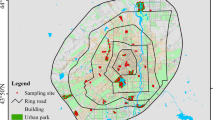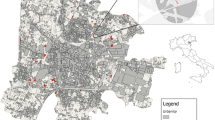Abstract
Chongming, the world’s largest alluvial island, is located within the municipality of Shanghai, China. Recent projects have now linked peri-urban Chongming to Shanghai’s urban core and as a result will soon undergo substantial changes from urbanization. We quantitatively analyzed the structure and composition of woody vegetation across subtropical, peri-urban Chongming as a basis for sustainable management of these rapidly urbanizing subtropical ecosystems elsewhere. We used 178 permanent, random plots to statistically and spatially analyze woody plant composition and tree structure across the 1,041 km2 of Chongming. A total of 2,251 woody plants were measured comprising 42 species in 37 genera. We statistically and geospatially analyzed field data according to land uses and modeled air pollution removal by trees. Average tree diameter at breast height, total height, and crown widths on transportation land uses were greater than other land uses. These same values were lowest on forest land use and greater tree cover was associated with areas of increased anthropogenic activity. Less than 20 % of the woody vegetation was exotic and a species richness index was significantly different between land uses due to legacy effects. Composition of agriculture and forest land uses were similar to residential and transportation. Tree cover across Chongming was also estimated to annually remove 1,400 tons of air pollutants. We propose that this integrated and quantitative method can be used in other subtropical, peri-urban areas in developing countries to establish baseline trends for future sustainability objectives and to monitor the effects of urbanization and climate change.




Similar content being viewed by others
References
Baumgardner D, Varela S, Escobedo F, Chacalo A, Ochoa C (2012) The role of a peri-urban forest on air quality improvement in the Mexico City Megalopolis. Environ Pollut 163:174–183
Bechtold WA (2003) Crown position and light exposure classification—an alternative to field assigned crown class. North J Appl For 20:154–160
Cheng H, Hu Y (2010) Planning for sustainability in China’s urban development: status and challenges for Dongtan eco-city project. J Environ Monit 12:119–126
Christopoulou O, Polyzos S, Minetos D (2007) Peri-urban and urban forests in Greece: obstacle or advantage to urban development? Manag Environ Qual 18:382–395
De la Maza CL, Hernández J, Bown H, Rodríguez M, Escobedo F (2002) Vegetation diversity in the Santiago de Chile urban ecosystem. Arboric J 26:347–357
Du Q, Zhang C, Wang K (2011) Suitability analysis for greenway planning in China: an example of Chongming Island. Environ Manag 49:96–110
Escobedo F, Nowak DJ (2009) Spatial heterogeneity and air pollution removal by an urban forest. Landsc Urban Plan 90:102–110
Escobedo F, Nowak DJ, Wagner JE, De la Maza C, Rodriguez M, Crane DE, Hernández DJ (2006) The socioeconomics and management of Santiago de Chile’s public urban forests. Urban For Urban Green 4:105–114
Escobedo F, Varela S, Zhao M, Wagner J, Zipperer W (2010) The efficacy of subtropical urban forests in offsetting carbon emissions from cities. Environ Sci Policy 13:362–372
Flock J, Escobedo F, Varela S, Wald C, Wade J (2011) Environmental justice implications of urban tree cover in Miami-Dade County, Florida. Environ Justice 4:125–134
Gamma Design Software (2001) GS+: geostatistics for the environmental science. Gamma Design Software, Plainwell
Godefroid S, Koedam N (2003) Identifying indicator plant species of habitat quality and invisibility as a guide for peri-urban forest management. Biodivers Conserv 12:1699–1713
Goovaerts P (1997) Geostatistics for natural resources evaluation. Oxford University Press, Oxford, p 496
Grau HR, Hernandez ME, Gutierrez J, Gasparri NI, Casavecchia MC, Flores-Ivaldi EE, Paolini L (2008) A peri-urban neotropical forest transition and its consequences for environmental services. Ecol Soc 13(1):35
Huang B, Ouyang Z, Zheng H, Zhang H, Wang X (2008) Construction of an eco-island: a case study of Chongming Island, China. Ocean Coast Manag 51:575–588
Jiangsu Institute of Botany (1977) The flora of Jiangsu. Jiangsu People’s Publishing House, Nanjing
Jim CY (2002) Heterogeneity and differentiation of the tree flora in three major land uses in Guangzhou City, China. Annu For Sci 59:107–118
Jim CY, Chen WY (2006) Recreation-amenity use and contingent valuation of urban green space in Guangzhou, China. Landsc Urban Plan 75:81–96
Jim CY, Liu HT (2001) Species diversity of three major urban forest types in Guangzhou City, China. For Ecol Manag 146:99–114
Kowarik I (2011) Novel urban ecosystems, biodiversity, and conservation. Environ Pollut 159:1974–1983
Luy L, Ma A, MA Q (2012) Spatial and temporal variations of vegetation coverage in coastal peri-urban area: a case study of Laoshan District, Qingdao. Environ Sci Technol (China) 35:178–185
Ma Z, Wany Y, Gan X, Li B, Cai Y, Chen J (2009) Waterbird population changes in the wetlands at Chongming Dongtan in the Yangtze River estuary, China. Environ Manag 43:1187–1200
McPherson GE (1998) Structure and sustainability of Sacramento’s urban forest. J Arboric 24:174–190
Mohamed MOS, Neukermans G, Kairo JG, Dahdouh-Guebas F, Koedam N (2009) Mangrove forests in a peri-urban setting: the case of Mombasa (Kenya). Wetl Ecol Manag 17:243–255
Normile D (2008) China’s living laboratory in urbanization. Science 319:740–743
Nowak DJ, Crane DE, Stevens JC, Ibarra M (2002) Brooklyn’s Urban Forest. General Technical Report NE-290, USDA, Forest Service, Northeastern Forest Experiment Station, Radnor, Pennsylvania
Pedlowski MA, Carneiro Da Silva VA, Corabi Adell JJ, Heynen C (2002) Urban forest and environmental inequality in Campos Dos Goytacazes, Rio de Janeiro, Brazil. Urban Ecosyst 6:9–20
Puric-Mladenovic D, Kenney WA, Csillag F (2000) Land development pressure on peri-urban forests: a case study in the regional municipality of York. For Chron 76:247–250
Ran L, Zhao C, Geng F, Tie X, Tang X, Peng L, Zhou G, Yu Q, Xu J, Guenther A (2009) Ozone photochemical production in urban Shanghai, China: analysis based on ground level observations. J Geophys Res 114:D15301, 14p
Shanghai Academy of Science; SAS (1999) The flora of Shanghai. Shanghai Science and Technology Publishing House, Shanghai
Shen G, Qian Z, Xu J, Sarris A (2009) Spatial variability of soil nutrient in Chongming of Shanghai, China by using GIS and Kriging method. In: Proceedings of the 2009 WRI Global Congress on intelligent Systems—volume 02. GCIS. IEEE Computer Society, Washington, DC, pp 479–483. doi:http://dx.doi.org/10.1109/GCIS.2009.72. Accessed 19–21 May 2009
Stewart GH, Meurk CD, Ignatieva ME, Buckley HL, Magueur A, Case BS, Hudson M, Parker M (2009) Urban Biotopes of Aotearoa New Zealand (URBANZ) II: floristics, biodiversity and conservation values of urban residential and public woodlands, Christchurch. Urban For Urban Green 8:149–162
The Economist (2010) Shanghai’s Chongming Island. Stepping Stone: an Island no more. The Economist, January 19, 2010. http://www.economist.com/node/15320662. Accessed 1 Oct 2012
Tian B, Zhou Y, Zhang L, Yuan L (2008) Analyzing the habitat suitability for migratory birds at the Chongming Dongtan Nature Reserve in Shanghai, China. Estuar Coast Shelf Sci 80:296–302
Tian B, Zhang L, Wang X, Zhou W, Zhang W (2010) Forecasting the effects of sea-level rise at Chongming Dongtan Nature Reserve in the Yangtze Delta, Shanghai, China. Ecol Eng 36:1383–1388
UNDESA (2008) World urbanization prospects—the 2007 revision. United Nations Department of Economic and Social Affairs, Population Division. ESA/WP/205. http://www.un.org/esa/population/publications/wup2007/2007WUP_Highlights_web.pdf. Accessed 2 April 2012
Vanclay JK (2003) Realizing opportunities in forest growth modeling. Can J For Res 33:536–541
Wang RJ, Zhao M, Gao J (2011) Carbon storage of main vegetation types of urban forest, Chongming Island of China. Scientia Geographica Sinica 31:490–494
Yang J, McBride J, Zhou J, Sun Z (2005) The urban forest in Beijing and its role in air pollution reduction. Urban For Urban Green 3:65–78
Yuan W, James P, Hodgson K, Hutchinson S, Shi C (2003) Development of sustainability indicators by communities in China: a case study of Chongming County, Shanghai. J Environ Manag 68:253–261
Zhao B, Kreuterb U, Ma Z, Chen J, Nakagoshi N (2004) An ecosystem service value assessment of land-use change on Chongming Island, China. Land Use Policy 21:139–148
Zhao S, Da L, Tang Z, Fang H, Song K, Fang J (2006) Ecological consequences of rapid urban expansion: Shanghai, China. Front Ecol Environ 4:341–346
Zhao M, Escobedo F, Staudhammer C (2010a) Spatial patterns of a subtropical, coastal urban forest: implications for land tenure, hurricanes, and invasives. Urban For Urban Green 9:205–214
Zhao M, Kong Z, Escobedo F, Gao J (2010b) Impacts of urban forests on offsetting carbon emissions from industrial energy use in Hangzhou, China. J Environ Manag 91:807–813
Zhong SB, Xue Y, Cao CX, Cao WC, Li XW, Guo JP, Fang LQ (2005) Explore disease mapping of Hepatitis B using geostatistical analysis techniques. In: Sunderam VS, Albada GD, Sloot PMA, Dongarra JJ (eds): Computational science—ICCS 2005, LNCS 3516. 5th International Conference, Atlanta, GA, USA, May 22–25, 2005, Proceedings, Part III. Springer Berlin, pp 464–471
Zong Y, Chen X (1999) Typhoon hazards in the Shanghai area. Disasters 23:66–80
Acknowledgments
We are grateful to Sebastian Varela for UFORE modeling, as well as Nilesh Timilsina and the two anonymous reviewers for reviews. This research was supported and funded by The Natural Science Foundation of China (31100354, 40801168, and 40871256), the Scientific Research Foundation for the Returned Overseas Chinese Scholars, State Education Ministry, The Leading Discipline Project of Shanghai Municipal Education Commission (J50402).
Author information
Authors and Affiliations
Corresponding author
Rights and permissions
About this article
Cite this article
Zhao, M., Escobedo, F.J., Wang, R. et al. Woody Vegetation Composition and Structure in Peri-urban Chongming Island, China. Environmental Management 51, 999–1011 (2013). https://doi.org/10.1007/s00267-013-0025-9
Received:
Accepted:
Published:
Issue Date:
DOI: https://doi.org/10.1007/s00267-013-0025-9




